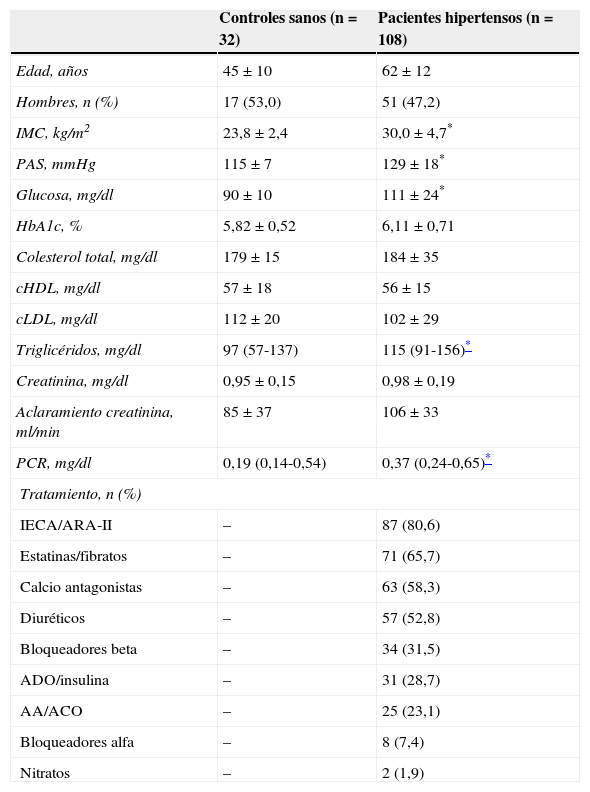Muchos pacientes hipertensos óptimamente tratados de sus factores de riesgo cardiovascular (FRCV) siguen presentando complicaciones cardiovasculares. Las células progenitoras endoteliales (CPE) han demostrado ser fundamentales para la reparación del daño endotelial en tejidos isquémicos. Por ello, hemos estudiado los niveles de CPE y del factor de crecimiento del endotelio vascular (VEGF) en pacientes hipertensos en tratamiento con buen control de la presión arterial (PA).
Material y métodosSe recogió una muestra de sangre de pacientes hipertensos tratados que presentaban unas cifras de PA adecuadas para los objetivos individuales. Los niveles plasmáticos de CPE CD34+/KDR+ y CD34+/VE-cadherina+ se midieron mediante citometría de flujo. La concentración de VEGF se cuantificó mediante ELISA. Como controles se incluyó un grupo de sujetos sin FRCV tradicionales.
ResultadosHemos incluido 108 pacientes (61±12 años, 47,2% hombres), de los cuales un 82,4% presentaba PA<140/90 mmHg, un 91,7% control de la diabetes (HbA1c < 7%), el 81,5% cLDL < 130 o 100 mg/dl y el 85,2% no fumaba, aunque el 45,4% presentaba obesidad (IMC ≥ 30 kg/m2). A pesar de que, en conjunto, sus parámetros bioquímicos no diferían de los del grupo control, los pacientes hipertensos presentaban una disminución significativa de los niveles plasmáticos de células CD34+/KDR+ y CD34+/VE-cadherina+, aunque la concentración plasmática de VEGF era significativamente mayor en los pacientes hipertensos que en los sujetos control.
ConclusionesLos pacientes hipertensos tratados muestran una disminución significativa de los niveles plasmáticos de CPE que podría ser responsable, al menos en parte, del riesgo residual que presentan estos pacientes, sugiriéndose que las CPE podrían ser una importante diana terapéutica.
Most optimally treated hypertensive patients still have an around 50% increased risk of any cardiovascular event, suggesting the possible existence of unidentified risk factors. In the last years there has been evidence of the essential role of circulating endothelial progenitor cells (EPCs) in the maintenance of endothelial integrity and function, increasing the interest in their involvement in cardiovascular disease. In this study, the circulating levels of EPCs and vascular endothelial growth factor (VEGF) are investigated in treated hypertensive patients with adequate control of blood pressure (BP).
Material and methodsBlood samples were collected from treated hypertensive patients with controlled BP. Plasma levels of EPCs CD34+/KDR+ and CD34+/VE-cadherin+ were quantified by flow cytometry. Plasma concentration of VEGF was determined by ELISA. A group of healthy subjects without cardiovascular risk factors was included as controls.
ResultsA total of 108 hypertensive patients were included (61±12 years, 47.2% men) of which 82.4% showed BP<140/90 mmHg, 91.7% and 81.5% controlled diabetes (HbA1c <7%) and cLDL (<130 or 100 mg/dL), respectively, and 85.2% were non-smokers. Around 45% of them were obese. Although patients had cardiovascular parameters within normal ranges, they showed significantly lower levels of CD34+/KDR+ and CD34+/VE-cadherin+ compared with healthy control group, although plasma VEGF concentration was higher in patients than in controls.
ConclusionsDespite an optimal treatment, hypertensive patients show a decreased number of circulating EPCs that could be, at least in part, responsible for their residual cardiovascular risk, suggesting that these cells could be a therapeutic target.
Artículo
Comprando el artículo el PDF del mismo podrá ser descargado
Precio 19,34 €
Comprar ahora












